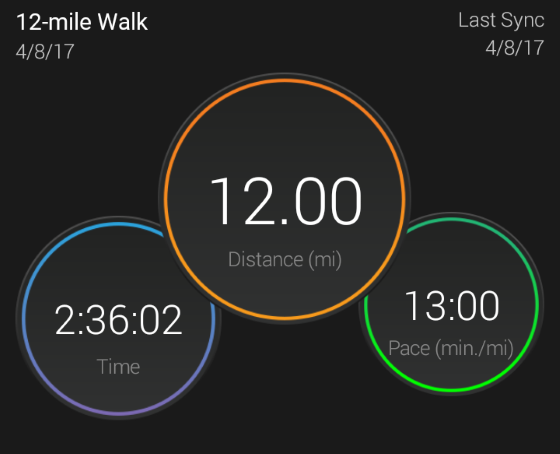Paced Running: Killer Buds, or Ticking Bomb? You Decide

Paced running: Would you like to run at a consistent pace?
I’ll start by defining paced running, which I’ll then compare to fartleks. I’ll show how paced running can help you. I’ll explain how the concept applies to walkers and run:walk athletes, too. I’ll review three common approaches to pace your running. And, I’ll show you an uncommon approach that is lightweight, less expensive, and safer.
Paced running? I’ve never heard of it
I made up the term. “Rhythmic running” was my original name for it, but Budd Coates and Claire Kowalchik beat me to it.
- Coates and Kowalchik use “rhythmic running” to refer to a breathing technique for runners.
- I use “paced running” to refer to running at a steady cadence.
Who fartleked?
When I was in junior college, I had to take two physical-education courses. (Remember those?) I took two summer terms of bowling and raised my average score from 100 to 150. Later, when I attended a university, I had to take two more phys-ed courses. I took two “Jogging for Fitness” courses.
When the weather was good, we ran outside. When it was too cold, though, we ran around a track elevated above a basketball court at the university. I don’t recall how much wider and longer the track was. But, I did the loops/mile arithmetic, based on the dimensions of an NCAA-approved college court. And, I estimate that we had to run at least 10 loops/mile around that elevated track. That was a memorable — and mind-numbing — way to run.
What also was memorable was a word that they taught us in the classroom instruction: fartlek. It means “speed play” in Swedish, and it refers to repeating periods of faster and slower running. Many of us laughed at the “fart” part of the word and how “lek” sounded like “lick”, but it stuck with us as a way to train.
I like fartlek training, especially in hill workouts. It’s a great way to train for obstacles. But, it’s also the opposite of paced running.
How can paced running help me?
Paced running has you focus on your cadence. This works because you get a continuous metric against which to compare your running. And, yes, cadence and stride together determine pace. But, …
[Tweet “It’s much easier to run at a faster pace by increasing your cadence than by lengthening your stride.”]
Paced running can help you in three ways to run faster:
- You train your body for a particular cadence.
- You can increase your pace by increasing your cadence over a training season.
- A predictable cadence in a given run lets you relax into the run.
Plus, the predictability of a paced run means:
- You can keep your heart rate in a non-stressful range.
- You avoid the panic of going anaerobic with a too-fast pace.
- You can better estimate when you’ll hit different distances in a run.
What if I’m a walker or run:walk athlete?
The concept of paced running applies to walkers and run:walk athletes, too.
There are many books to help runners to run faster. My favorite is The Running Revolution, which taught me to run on the balls of my feet (instead of heel-striking).
In contrast, learning to become a faster walker can be challenging. But, when I applied the concept of paced running to my walking, I became a faster walker. All that I had to do was focus on increasing my cadence by a few steps/minute each week.
For example, here are my average paces over eight sequential Saturday-morning walks:
- Saturday #1: 15:01/mile over 6 miles
- Saturday #2: 14:45/mile over 8 miles
- Saturday #3: 14:09/mile over 9 miles
- Saturday #4: 14:22/mile over 9 miles
- Saturday #5: 13:48/mile over 10 miles
- Saturday #6: 13:38/mile over 9 miles
- Saturday #7: 13:13/mile over 10 miles
- Saturday #8: 13:00/mile over 12 miles

Run:walk athletes have it almost as easy as runners or walkers. They need only combine paced running and paced walking.
How are many paced runners putting themselves in danger?
Many runners pace themselves by listening to music that has a certain beat. This makes sense from a performance perspective. For example, a study out of Liverpool, UK, found that cyclists worked harder with faster music. And, the author of Inside Sport Psychology says that music can boost a runner’s performance by 15%. There are even guides for finding music that will match your cadence.
Building fresh, long playlists can get tedious, but suppose that this does not bother you. Then how will you listen to your playlist while on the run? You have three options:
- A portable speaker
- Earbuds
- Bone-conduction headphones
Let’s look at each:
- If you run with music playing through a speaker, you can wake the neighbors and annoy other runners. Plus, even if you turn down the music, portable speakers are often heavy.
-
Earbuds are now light, waterproof, and/or Bluetooth-enabled. But, running with earbuds can get you killed.
-
Bone-conduction headphones give you situational awareness because they are not in your ears. But, they are expensive when compared to earbuds.
Most people who run with music choose earbuds. To avoid injury or death, I’ve recommended putting an earbud in only one ear. But, many runners find one-ear music worse than no music.
So, how can I be safe as a paced runner?
I recommend running with a step beeper — my name for a portable metronome that you clip to your cap, jersey, or hydration belt.
- You can adjust the volume for noisy or quiet neighborhoods.
- You can adjust the tempo to match your cadence.
- You can adjust the sound pattern to match your preference.
For example, …
[Tweet “I use a tick-tock pattern for a nice left-foot/right-foot rhythm.”]
A step beeper beats the music-based approaches in seven ways:
- It’s as light as earbuds or bone-conduction headphones and lighter than a speaker.
- It’s cheaper than a speaker or bone-conduction headphones and as inexpensive as earbuds.
- It’s as safe as a speaker or bone-conduction headphones and safer than earbuds.
- You don’t have to manage music playlists.
- You can have music-free conversations with fellow runners.
- A step beeper displays your current cadence.
- A step beeper lets you change your cadence without waiting for the next song.
One drawback to a step beeper is that it sounds like a ticking bomb. But, you can turn down the volume so only you hear it unless another runner is super-close to you. And, you can use it as a conversation-starter to meet new runners.
What next?
By running with a step beeper instead of with music, you’ll be a happier, safer runner.
Now that you know about step beepers, get one … or two, if you’re a run:walk athlete. Seiko makes my favorite.
Interested? Click here:
Image Credit: Pixabay
